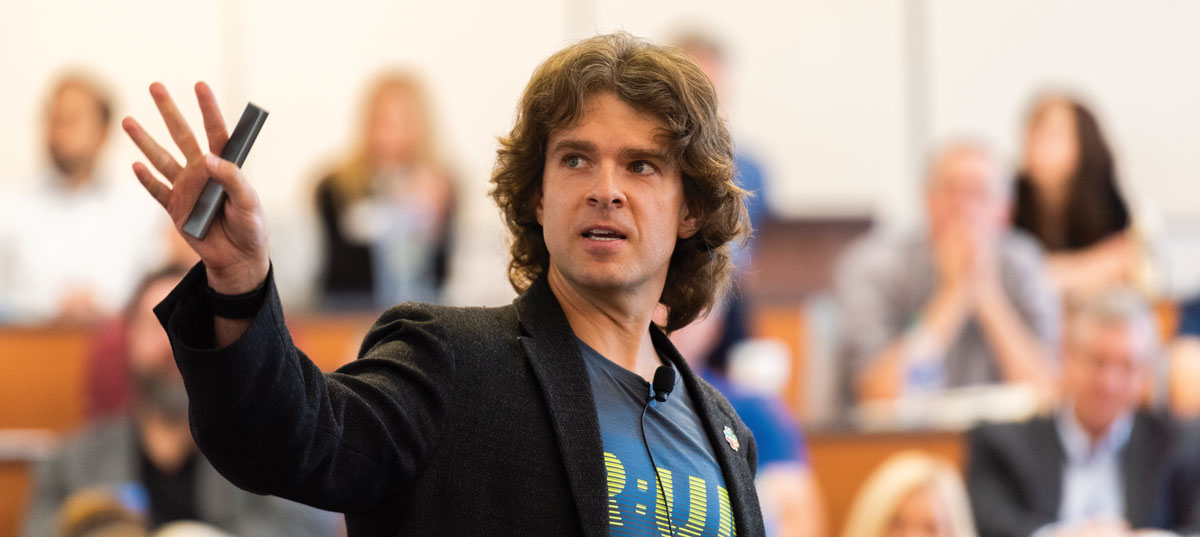efore the COVID-19 pandemic, quarterly Teaching & Learning workshops helped W. P. Carey faculty connect from across the school to reinforce excellence in classroom practices. They shared the best methods to engage students and tips and tricks for using technology in the classroom.
Amid COVID-19-related school disruptions, Teaching & Learning workshops have become even more crucial as faculty have had to lean on one another to learn how to engage strategically with students online.
Matt Sopha, a clinical associate professor of information systems, shares ways faculty can connect and collaborate with students online through Slack, a collaborative workspace for teams.
“It’s easy to write this off as another chat app,” Sopha says. “It’s not.” The communication platform allows users to organize chat rooms by topic, create private groups, and send direct messages, and it’s particularly useful for remote learning and teamwork.
Sopha began using Slack specifically for remote students. “There’s a distance that exists between faculty and students and between students and their peers,” he says. “I wanted to reduce that metaphorical distance. I wanted students to know someone was on the other end, whether that’s me or their classmates.
“The thing missing for remote classes is the classroom,” Sopha continues. He mimics the classroom setting in Slack with team channels for students to work on projects together. He also establishes team channels for broadcasting his announcements and asking questions about homework and getting answers from him.
“As faculty, we remember learning is a team sport,” he says. “It’s a collaborative effort.”
Sopha urges faculty to use Slack with their students moving forward, because it creates an environment for them to communicate easily.
One of his students wrote in an evaluation: “Slack was revolutionary. Dr. Sopha was the first instructor at ASU that I had a conversation with on the platform. Being able to talk to him and my classmates on Slack made the class so much better than other classes I’ve taken. I never got the feeling that he was phoning anything in even though this is a remote class. When I used to take traditional, in-person classes, I felt disconnected and separated from everyone around me. The remote class experience is even more isolating. Through Slack, I felt more involved and connected than I’ve ever felt in any college course. It felt natural and easy to reach out for help or talk to my peers about a homework assignment.”

Lauren Chenarides, assistant professor at the Morrison School of Agribusiness, recently shared a presentation that discussed tips for helping succeed in a remote study group work.
Chenarides’ remote course, Food Supply Networks, examines the forces driving disruptive changes in the food system and uses case studies to illustrate how economic, social, and environmental consequences on supply chains affect the food system. When she took over the class in spring 2018, 27 students were enrolled and 100% of the class assignments were individually focused. After enrollment grew to 71 students the next semester, she decided to convert some of the individual assignments into group work, such as reformatting a weekly case study project into a group submission.
“Most of the students in this course come in with 87 credit hours, which means some of them enrolled in my class are not business majors,” Chenarides explains. “I thought group work would promote interdisciplinary learning, and students could learn from one another.”
At the beginning of the semester, Chenarides assembles students in teams of six and sets guidelines for group work and the final project. The student groups get a case study that includes six tasks so that in theory, each student in the group is responsible for one of these tasks.
It’s important to understand the remote student, Chenarides says. “I’m here to tell you that remote learning is possible although students are working from different states and even other countries. Many work 20-plus hours a week, and are enrolled in various disciplines.”
Chenarides talks about the COVID-19 transition. “Now with 111 students, I kept groups for my class, as well as incorporated Slack since learning more about it from Professor Sopha’s presentation, and it ran very smoothly.”
Marcie LePine, associate professor of management and entrepreneurship, shares best practices for connecting with students in a remote class, focusing on making things personal. “Before I begin, I ask myself, ‘How will I create a learning community? How will I bring my course to life?’ ”
To create a learning community, LePine uses topic-based discussion boards. “This gives everyone a voice. Introverts have time to reflect so they can comment as well.” While discussion boards help bring a course to life, LePine also immerses the students in the class material with surveys that show how organizational behavior relates to them and their workplaces. “I want learning to become personal, just like business is personal,” she says.
Countless faculty members across ASU like Sopha, Chenarides, and LePine have transitioned from in-person classes to remote classes for COVID-19. Amy Hillman, W. P. Carey School dean, spoke at a webinar hosted by the Financial Times. “We got lucky that we’ve been in the business of online degrees. We already had the infrastructure to quickly prop up teaching workshops and trainings on Zoom that faculty could jump right into,” she says.
Whether it’s maintaining a sense of community online or helping students collaborate with their classmates remotely, professors have shown their continued commitment to teaching and learning during a difficult time.